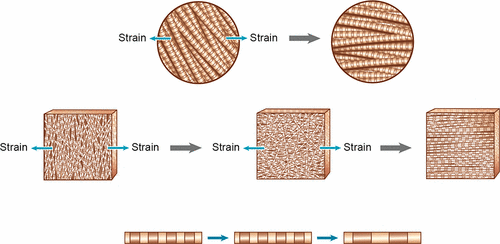当前位置:
X-MOL 学术
›
ACS Biomater. Sci. Eng.
›
论文详情
Our official English website, www.x-mol.net, welcomes your
feedback! (Note: you will need to create a separate account there.)
Collagen Fibril Response to Strain in Scaffolds from Ovine Forestomach for Tissue Engineering
ACS Biomaterials Science & Engineering ( IF 5.4 ) Pub Date : 2017-09-05 00:00:00 , DOI: 10.1021/acsbiomaterials.7b00588 Katie H. Sizeland 1, 2 , Hannah C. Wells 1 , Susyn J.R. Kelly 1 , Keira E. Nesdale 1 , Barnaby C. H. May 3 , Sandi G. Dempsey 3 , Christopher H. Miller 3 , Nigel Kirby 2 , Adrian Hawley 2 , Stephen Mudie 2 , Tim Ryan 2 , David Cookson 2 , Richard G. Haverkamp 1
ACS Biomaterials Science & Engineering ( IF 5.4 ) Pub Date : 2017-09-05 00:00:00 , DOI: 10.1021/acsbiomaterials.7b00588 Katie H. Sizeland 1, 2 , Hannah C. Wells 1 , Susyn J.R. Kelly 1 , Keira E. Nesdale 1 , Barnaby C. H. May 3 , Sandi G. Dempsey 3 , Christopher H. Miller 3 , Nigel Kirby 2 , Adrian Hawley 2 , Stephen Mudie 2 , Tim Ryan 2 , David Cookson 2 , Richard G. Haverkamp 1
Affiliation

|
Scaffold biomaterials are typically applied surgically as reinforcement for weakened or damaged tissue, acting as substrates on which healing tissue can grow. Natural extracellular matrix (ECM) materials consisting mainly of collagen are often used for this purpose, but are anisotropic. Ovine forestomach matrix (OFM) ECM was exposed to increasing strain and synchrotron-based SAXS diffraction patterns and revealed that the collagen fibrils within underwent changes in orientation, orientation index (a measure of isotropy), and extension. Response to the strain depended on the direction the collagen fibrils were oriented. When the ECM was stretched in the direction of collagen fibril orientation, the fibrils become more oriented and begin to take up the strain immediately (as shown by the increased d-spacing). Stretch applied perpendicular to dominant fibril direction caused the fibrils to initially become less oriented as they were pulled away from the original direction, and less force was initially transmitted along the length of the fibrils (i.e., the d-spacing changed less). SAXS analysis of OFM and the starting raw tissue showed there is no difference in the structural arrangement of the collagen fibrils. Understanding the directional structural response of these materials under strain may influence how surgeons select and place the materials in use.
中文翻译:

胶原蛋白原纤维对应变的反应从绵羊Forestomach组织工程的支架中。
支架生物材料通常通过外科手术方式用作弱化或受损组织的增强材料,并充当可在其上生长愈合组织的基质。主要由胶原蛋白组成的天然细胞外基质(ECM)材料通常用于此目的,但具有各向异性。羊前胃基质(OFM)ECM暴露于不断增加的应变和基于同步加速器的SAXS衍射图中,并揭示了其中的胶原原纤维的方向,方向指数(各向同性的量度)和延伸度发生了变化。对菌株的反应取决于胶原纤维的取向方向。当ECM沿胶原原纤维取向的方向拉伸时,原纤维变得更取向并立即开始吸收应变(如d的增加所示)。-间距)。垂直于主要原纤维方向施加的拉伸导致原纤维在被拉离原始方向时最初变得较不定向,并且最初沿原纤维的长度传递的力较小(即d间距变化较小)。SAXS对OFM和原始原始组织的分析表明,胶原原纤维的结构排列没有差异。了解这些材料在应变下的定向结构响应可能会影响外科医生选择和放置材料的方式。
更新日期:2017-09-05
中文翻译:

胶原蛋白原纤维对应变的反应从绵羊Forestomach组织工程的支架中。
支架生物材料通常通过外科手术方式用作弱化或受损组织的增强材料,并充当可在其上生长愈合组织的基质。主要由胶原蛋白组成的天然细胞外基质(ECM)材料通常用于此目的,但具有各向异性。羊前胃基质(OFM)ECM暴露于不断增加的应变和基于同步加速器的SAXS衍射图中,并揭示了其中的胶原原纤维的方向,方向指数(各向同性的量度)和延伸度发生了变化。对菌株的反应取决于胶原纤维的取向方向。当ECM沿胶原原纤维取向的方向拉伸时,原纤维变得更取向并立即开始吸收应变(如d的增加所示)。-间距)。垂直于主要原纤维方向施加的拉伸导致原纤维在被拉离原始方向时最初变得较不定向,并且最初沿原纤维的长度传递的力较小(即d间距变化较小)。SAXS对OFM和原始原始组织的分析表明,胶原原纤维的结构排列没有差异。了解这些材料在应变下的定向结构响应可能会影响外科医生选择和放置材料的方式。









































 京公网安备 11010802027423号
京公网安备 11010802027423号